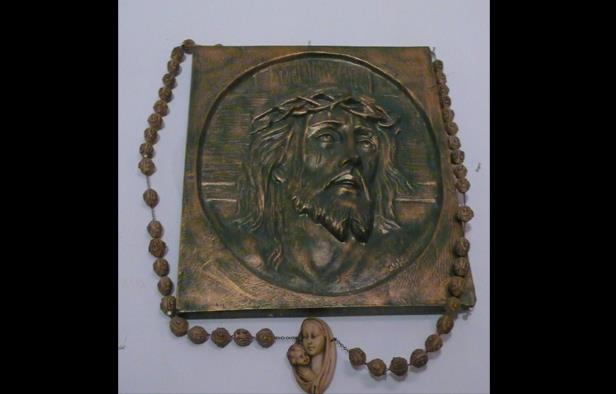The story of a Lebanese sculptor
Moulding a grand Lebanese narrative out of stone, bronze, and gypsum

If you ignore the dust and cobwebs, it is hard to believe that Halim El-Hajj (1915-1990) last worked in his studio over 20 years ago. The sculptor, who grew up in the village of Bejjé (16km above Byblos,) left many things behind in the studio: medallions, busts of well-known Lebanese and foreign (mostly French) personalities, stone and bronze, as well as moulds. The room is bright but the high windows prevent views of the valley below from proving distracting. The garden and foyer of the house are peppered with statues and medallions, and Hajj’s nephew plans to turn it into a museum one day.
Hajj’s work-coats hang near a shelf on which two packets of ‘South’ cigarettes rest. There are black and white photographs and sketches of politicians, poets, generals, writers, singers, clerics, saints and Phoenicians, as well as awards, adorning the walls. Inside one of the drawers of a worktable there are black and white photographs of French singer Mireille Mathieu and a list the artist drew up of “il ne faut pas oublier” (things “one ought not to forget” in English), which includes “the joy of creating.”
Models of one of El-Hajj’s most famous projects – his designs for five and ten Lebanese Piastres coins issued in 1955 – hang in the house, where his widow, Rosa, still lives.
Now in her 80s, Rosa, who is originally from Rome, met Halim through her father, also an artist, who had befriended the Lebanese student while Halim was studying in Italy. Rosa and Halim were married in the chapel at the Vatican before returning to Lebanon in 1952, where at first they split their time between Beirut and Bejjé.
Rosa recalls how on first arriving to Lebanon she was surrounded by Arabic-speaking people, but did not understanding anything, she’d ask “que dice” (what is he/she saying?) A year in and she spoke Arabic. Now, she switches between Arabic, French, and Italian with ease and gusto.
Until the war in 1975, when the Hajjs moved to Bejjé quasi permanently, they would attend one or two exhibitions and openings each week and had many artist friends. Art critic Cesar Nammour vividly recalls Rosa as a stylish figure on the local art scene, and Rosa’s photo albums – in which Halim resembles the Italian film actor, Marcello Mastroianni – bear out her statement that they enjoyed life to the fullest (“on vivait la belle vie.”)
In a chapter of his book, Sculpture in Lebanon, which was published in 1990, Nammour compares the work of Alfred Basbous with that of Hajj. The two sculptors, who were friends and grew up in villages quite close to each other, took very different artistic trajectories. While Basbous, after having been exposed to modernism during his studies in France, went on a daring quest to discover the ultimate shape, Hajj would, according to Nammour, remain a technician for the rest of his career. Both Hajj’s subject matter and his style remained consistently classical and academic, possibly as a result of the two years he spent working on ancient excavation sites in Byblos as a teenager. Indeed, in a monograph published in 1965, Hajj wrote: “those jobs and excavations had a deep effect on me; they made me love historic traces and common places. They also initiated in me the conceptions of the great heritage of my country, made me attached to its sacred soil, and practice the deep research into our old historical culture.”
Nammour further believes that Hajj was influenced by his mentor, Joseph Howayyek. Howayyek had been given a studio in the grounds of Charles Corm’s Beirut property. Corm, a well-known businessman, philanthropist, and poet, who also gave Hajj a workspace, financed Lebanon’s stand at the 1939 World Fair in New York to which Hajj contributed some work.
Hajj would inevitably have been influenced by Corm’s literary output, which included the influential journal he began to publish in 1920, La Revue Phénicienne. No doubt also of interest was Corm’s Phoenician movement, and the associated quest of some painters such as César Gemayel and Omar Onsi, to establish a Lebanese style, distinct from the European models.
Religion was also a strong influence on Hajj’s work and a few religious statues remain in his studio and garden, including a Mar Charbel and several Madonnas. They are in the company of statues of General Charles de Gaulle, French singer Mireille Mathieu (who posed for Hajj when in Lebanon for her Byblos performance in 1974,) as well as local literary luminaries Mikhail Naimy and Khalil Gibran. A sculpture that seems to have been influenced by art nouveau is Elan, a nude, stretching to the heavens, of which there are versions in stone and gypsum in the garden and studio.
Hajj’s work, which used to be popular and sought after during his lifetime, can still be found across Lebanon. He was frequently commissioned by the Lebanese government or municipalities to produce large sculptures, amongst which is the ‘Phoenician Sailor,’ the seven meter high sculpture of Fakhreddine, which is mounted outside the Ministry of Defence, along with the busts of several Lebanese presidents and military commanders.
Whilst Hajj’s work is not studied in the current school or university curriculum, his output was part of a serious attempt to develop a distinct style of Lebanese sculpture and it made a valuable contribution to the Lebanese story arc.




